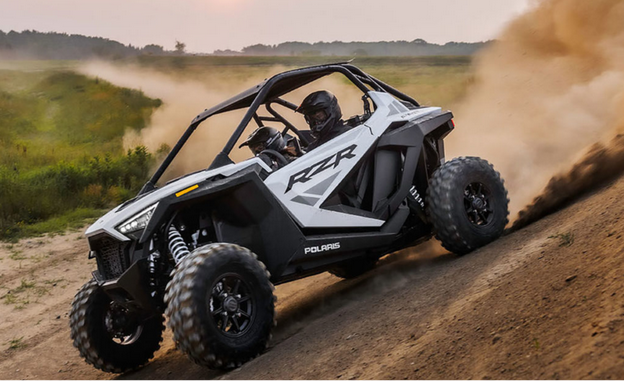Drive Belts 101: Everything You Need to Know About These Essential Quad Bike Components
Share
Share

Most ATVs and UTVs use a constantly variable transmission (CVT) to transfer engine power to the wheels. Drive belts are vital components that connect the transmission clutch pulleys and transfer power to the ground. Although reliable, they are some of the most stressed parts of a quad bike and often the first to require replacement. Loss of power, clutch slippage, and burning smells are signs that the factory belt is nearing its end.
CVTs are prevalent in quad bikes due to their efficient power transfer. They maximize engine torque while maintaining manageable RPMs, balancing power and longevity while reducing maintenance needs. Belts connect the primary and secondary clutch pulleys, helping maintain optimal engine revs under any load. Whether you’re thrashing your ATV downhill at full throttle or using a UTV for work, the belt is the crucial link between the engine and wheels.
With machines getting bigger and more powerful, and redlines increasing, ATV and UTV drive belts endure immense heat and impact, constantly elongating and contracting to achieve the right gear ratio. Larger UTVs and side-by-sides often generate over 100 horsepower and truckloads of torque, spinning at close to 10,000 RPM. The rubber cogs and Kevlar tensile cords that keep belts in one piece are tough, but they have their limits. If you enjoy longer rides at full throttle or regularly use your ATV for farm or construction work, a compatible replacement belt is essential to keep your fun or work uninterrupted.
If you’ve had more than a few belts snap, break, burn or disintegrate, you’ll be interested in why this happens. Several factors are to blame:
Other considerations include high engine loads, abrupt RPM swings, irregular inspections and maintenance, and where you ride. High torque and full throttle put more stress on the drive belts. Similarly, wringing the throttle fully out in seconds can cause issues. Look out for missing teeth, frayed cords, or dented belt sidewalls. While belts can last up to 5,000 miles on regular rides, additional stress and external factors like debris and heat significantly reduce their lifespan.
 When shopping for a new belt, you have two options: OE and aftermarket types. So, which fares better? Original equipment parts are the same as those used on the quad when new. They’re adequate for most riding conditions and scenarios but may not hold up on more demanding rides. That’s not to say they’re cheap.
When shopping for a new belt, you have two options: OE and aftermarket types. So, which fares better? Original equipment parts are the same as those used on the quad when new. They’re adequate for most riding conditions and scenarios but may not hold up on more demanding rides. That’s not to say they’re cheap.
Aftermarket UTV drive belts are offered by dozens of brands. These come in heavy-duty and extreme-duty variants with different purposes. Both have revised designs and often better materials to ensure they last longer and extract all the engine has to give. Think reworked cogs for smoother power transfer, materials that withstand higher elongation and compacting rates, and designs that last longer under higher temperatures and engine loads. Heavy-duty variants are a step above ordinary drive belts, handling heat, impact, and debris in quads with low to medium-displacement engines (around 700cc) and power numbers averaging between 50 and 100 hp. This covers most recreational ATVs and work-oriented UTVs and side-by-sides.
For more powerful machines putting out over 100hp, you’ll want extreme-duty drive belts. These need to handle higher torque and power outputs, more elongation, and significantly higher temperatures while providing smooth power transfer. They include composite or synthetic tensile cords (like aramids or Kevlar), synthetic rubbers (chloroprene, ethylene, or diene) to reduce wear and damage, and fabric covers to prevent debris and water infiltration. Besides more efficient power transfer, they’ll last longer under harder riding conditions.
Compatibility is the first thing to consider when buying a replacement ATV or UTV drive belt. This means wearing belts with the right tooth count and length to prevent fit or performance issues. Teeth must also be in the correct shape (trapezoidal, curvilinear, or modified curvilinear) to ensure smooth engagement with clutch pulleys and prevent potential damage to the transmission or engine if belts snap or shred. Besides fitment, check if your new belt is rated for your quad’s engine output.
Brands are your next consideration. This roughly aligns with the end price and the quality you’re getting. Go with established third-party brands (some also supply OE parts, including drive belts) such as Gates, and Dayco, or specialised belt brands like All Balls, Ultimax, and EPI. Often, you’ll find several belts that work with your quad from the same manufacturer but differ in price and performance. More expensive versions are built around the latest compounds and belt designs for smoother power delivery, higher efficiency, and lower wear.
Lastly, if you’re modifying your ATV or UTV for more power, upgrade the belts to handle the power additions. This ensures all components are balanced and that the belts fail before the transmission or engine does. Avoid bending, crimping, or flattening the part when fitting a new belt. Ensure that clutch surfaces are clean, and avoid incorrect installation. If you’re uneasy about installation, get a professional to fit it. With the new belt in place, keep things easy for the first few rides, avoid over-throttling, and allow the belt to cool down with frequent breaks. This correct belt break-in ensures it works and lasts as advertised.
Leave a Reply